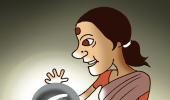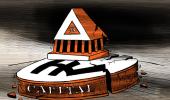'When bankers are hounded by investigative agencies for credit decisions going wrong and defaulters are treated like outcasts, who will borrow money and who will lend?' asks Tamal Bandyopadhyay.

Recently, the Reserve Bank of India conducted the second phase of Operation Twist by simultaneous buying and selling government securities.
It bought long-tenure bonds and sold short-term ones to bring down the bond yields and flatten the curve, narrowing the term premium.
The 10-year bond yield, which rose to 6.8 per cent in the recent past fearing higher government borrowing to bridge the widening fiscal deficit, is now hovering at 6.5 per cent.
Operation Twist 'managed' bond yields, brought down the cost of borrowing for the government and saved banks from treasury losses.
Banks, in fact, can make money trading bonds but nobody knows how long the RBI would continue the exercise and how much it would buy.
Therein lies the challenge for the banks.
What are their challenges in the new decade?
For the record, a decade ago, the 10-year bond yield was 7.59 per cent and 11.22 per cent in December 1999.
The gross annual government borrowing figures for fiscal year 2000, 2010 and 2020 have been Rs 99,630 crore, Rs 4.92 trillion and Rs 7.1 trillion respectively.
The kitty of bank credit, which is Rs 99.25 trillion now, was Rs 29.42 trillon in 2009 and Rs 4.15 trillion in 1999.
The credit pile grew 609 per cent in the first decade and less than half of it in the current decade.
The deposit portfolio of banks, which is Rs 1.31 trillion now, has grown 213 per cent in the current decade, roughly half the growth in the first decade (from Rs 7.91 trillion in 1999 to Rs 41.84 trillion in 2009).
How has the economy been growing? In 2000, it was Rs 20.13 trillion and in 2010, Rs 64.78 trillion (both 2004-2005 series).
The estimated size of the Indian economy in 2020 is Rs 211 trillion (2011-2012 series).
Finally, a look at the pile of bad assets.
In March 2019, the gross non-performing assets of the Indian banking sector was 9.1 per cent of the loans, the highest among emerging markets. It may rise to 9.9 per cent next year.
The figure was 2.39 per cent in March 2009 and 14.6 per cent in March 1999.
After making provisions, the net NPAs of the industry in March 2019 was 3.7 per cent, higher than 1.12 per cent in March 2009 but much lower than 7.5 per cent in March 1999.
Last decade started with enormous fiscal and monetary stimulus to ward off the feared impact of the collapse of US investment bank Lehman Brothers Holdings Inc.
The government went all out spending money and the RBI followed an ultra-loose monetary policy, flooding the system with liquidity and bringing down the policy rate to its historic low.
That sowed the seeds of the problems that plagued the financial sector for an entire decade, threatening to spill over to the next.
Former RBI governor Y V Reddy -- initially a much-disliked central banker for his refusal to open up the banking sector -- turned into a hero after the Lehman collapse for ring-fencing the Indian economy by not opening up the sector.
In the current decade, there has been partial opening up, but that is not the reason for the enormous pain that the Indian financial sector has been experiencing.
Unlike in the past when only the banking sector bore the brunt, the problem has spread across the financial system -- to non-banking finance companies, mutual funds and rating agencies.
There is a clamour for fiscal stimulus even as monetary easing continues.
How did we get into the mess?
Probably, each decade has its own contribution.
Some are blaming the abolition of development financial institutions (DFIs) in the 1990s that forced banks to lend for projects without the core competence.
They are extremely slow learners of the tricks of the trade; the leisurely development of the corporate bond market also did not help the cause.
A few are holding the Reddy regime responsible for the current troubles as the economy grew at over 9 per cent for three successive years then and the credit growth was phenomenal, leading to overheating.
Then, of course, there was the exaggerated response to the global crisis in the aftermath of the Lehman collapse.
And, finally, there are others who are blaming then prime minister Manmohan Singh and then RBI governor Raghuram Rajan for the mess.
India presents a unique case study of financial sector woes spilling over to the real sector. And there is no Lehman or East Asian crisis to blame. It is self-inflicted.
In the past too, Indian banks were saddled with bad assets, but there has never been such a crisis of confidence (which forced the RBI to issue a release saying depositors's money is safe in the banks).
Has the central bank been too aggressive in cleaning up the system?
Should it and the government have thought of the solutions before raising the red flags?
When bankers are hounded by investigative agencies for credit decisions going wrong and defaulters are treated like outcasts, who will borrow money and who will lend?
The endgame in the politician-banker-corporate house nexus has not played out yet.
Once it does, the new landscape for the Indian financial system will emerge.
In some sense, the Indian banking story has remained unchanged for decades.
Banks have kept on changing their assets -- from steel to infrastructure to telecom to retail -- and corporate India kept on leveraging up even as the regulator was generous in offering forbearance to banks.
Periodically, new currency in the form of the treasury gains has been used to clean up banks's balance sheets.
How long can it continue? At some point, there won't be anybody to lend barring the government -- the last bastion.
This is a classic story of debt stagnation and fiscal dominance.
In the new decade, we will see the emergence of large banks through consolidation; probably better-governed public sector banks with a smaller market share; the entry of many small banks; and even the return of DFIs in some form.
Let's hope and pray that we also see the closure of the bad loan saga.
Tamal Bandyopadhyay, a consulting editor with Business Standard, is an author and senior adviser to Jana Small Finance Bank Ltd.












 © 2025
© 2025